Educational Videos
Watch the Cerdelga (eliglustat) MOA video
Cerdelga (eliglustat) is indicated for the long-term treatment of adult patients with Gaucher disease type 1 who are CYP2D6 extensive metabolizers, intermediate metabolizers, or poor metabolizers as detected by an FDA-cleared test. Patients who are CYP2D6 ultra-rapid metabolizers may not achieve adequate concentrations of Cerdelga to achieve a therapeutic effect. A specific dosage cannot be recommended for those patients whose CYP2D6 genotype cannot be determined.
Gaucher disease type 1, the most common lysosomal storage disease, is a rare, autosomal recessive disease in which the accumulation of glucosylceramide results in progressive multi-organ dysfunction.
Glucosylceramide is synthesized in the Golgi by the enzyme glucosylceramide synthase, or GCS, and plays an essential role in cellular function.
Lysosomes are also involved in various cellular processes including intracellular digestion of macromolecules. When cells age or become damaged, their components are degraded and digested in the lysosome and recycled into new cellular components.
Glucosylceramide is metabolized by the lysosomal enzyme glucocerebrosidase. This process helps to maintain homeostasis within the cells.
In patients with Gaucher disease type 1, the rate of glucosylceramide production may exceed its rate of degradation. Deficient glucocerebrosidase enzyme activity causes glucosylceramide to accumulate in the lysosomes. Immune system responses to this buildup of glucosylceramide may contribute to an increase in GCS activity and further glucosylceramide production.
Residual enzyme activity is most likely not sufficient to counterbalance the increased production of glucosylceramide, which accumulates primarily in cells of the monocyte/macrophage lineage. The accumulation of Gaucher cells…
…in the liver, spleen, bone marrow, and other organs results in the signs and symptoms of Gaucher disease.
Treatments are available to help manage the signs and symptoms of Gaucher disease type 1, including oral therapies. Substrate reduction therapy, or SRT, is a class of medication that contains oral options. Cerdelga (eliglustat) is the only first line oral SRT treatment for most adults with Gaucher disease type 1 who are treatment naïve or want to switch from ERT infusions.
Cerdelga is an oral, noninvasive therapy that partially inhibits GCS, thereby slowing down the production and accumulation of glucosylceramide.
Cerdelga specifically inhibits glucosylceramide synthase, which slows the production of glucosylceramide substrate to a level that can be effectively cleared in the lysosomes with residual glucocerebrosidase enzyme activity.
By limiting the production of glucosylceramide substrate, Cerdelga aims to restore balance on the substrate pathway within the cells and reduce accumulation in the liver, spleen, and bone marrow.
Patient eligibility for Cerdelga is partly determined by CYP2D6 metabolizer status since Cerdelga is primarily metabolized by CYP2D6. CYP2D6 enzyme activity can vary among individuals, altering their response to drugs that are CYP2D6 substrates. A patient’s CYP2D6 metabolizer status will impact the bioavailability and effectiveness of Cerdelga in inhibiting GCS and glucosylceramide production.
Therefore, Cerdelga dosing is based on a patient’s CYP2D6 metabolizer status.
Important Safety Information
CONTRAINDICATIONS
CERDELGA is contraindicated in the following patients based on CYP2D6 metabolizer status due to the risk of cardiac arrhythmias from prolongation of the PR, QTc, and/or QRS cardiac intervals:
• Extensive Metabolizers (EMs) taking a strong or moderate CYP2D6 inhibitor concomitantly with a strong or moderate CYP3A inhibitor, EMs with moderate or severe hepatic impairment, or EMs with mild hepatic impairment and taking a strong or moderate CYP2D6 inhibitor.
• Intermediate Metabolizers (IMs) taking a strong or moderate CYP2D6 inhibitor concomitantly with a strong or moderate CYP3A inhibitor, IMs taking a strong CYP3A inhibitor, or IMs with any degree of hepatic impairment.
• Poor Metabolizers (PMs) taking a strong CYP3A inhibitor, or PMs with any degree of hepatic impairment.
WARNINGS AND PRECAUTIONS
CERDELGA is predicted to cause increases in ECG intervals (PR, QTc, and QRS) at substantially elevated plasma concentrations and may increase risk of cardiac arrhythmias. Use of CERDELGA is contraindicated, to be avoided, or requires dosage adjustment in patients taking CYP2D6 or CYP3A inhibitors, depending CYP2D6 metabolizer status, type of inhibitor, or degree of hepatic impairment. Avoid use of CERDELGA in patients with pre-existing cardiac disease, long QT syndrome, or in combination with Class IA or Class III antiarrhythmic medications.
ADVERSE REACTIONS
The most common adverse reactions (≥10%) to CERDELGA include: fatigue, headache, nausea, diarrhea, back pain, pain in extremities, and upper abdominal pain.
DRUG INTERACTIONS
Coadministration of CERDELGA with CYP2D6 or CYP3A inhibitors may increase eliglustat concentrations, which may increase the risk of cardiac arrhythmias from prolongations of the PR, QTc, and/or QRS cardiac interval. Use of CERDELGA is contraindicated, to be avoided, or may require dosage adjustment depending on the concomitant drug and CYP2D6 metabolizer status. See section 7 of the full Prescribing Information for more details and other potentially significant drug interactions.
USE IN SPECIFIC POPULATIONS
Available data on the use of CERDELGA in pregnant women is not sufficient to assess drug-associated risks of major birth defects, miscarriage, or adverse maternal or fetal outcomes. The developmental and health benefits of breastfeeding should be considered along with the mother’s clinical need for CERDELGA and any potential adverse effects on the breastfed child from CERDELGA or from the underlying maternal condition.
Use of CERDELGA in patients with renal impairment is based on the patient’s CYP2D6 metabolizer status. Avoid use of CERDELGA in EMs with end-stage renal disease (ESRD), and IMs and PMs with any degree of renal impairment.
Use of CERDELGA is contraindicated or may require dosage adjustment in patients with hepatic impairment based on CYP2D6 metabolizer status, concomitant use of CYP2D6 or CYP3A inhibitors, and degree of hepatic impairment.
Please see accompanying full Prescribing Information.
For more information on Cerdelga for your eligible patients with Gaucher disease type 1, speak to your local Sanofi representative for more information.
Watch a video of a real patient who switched to Cerdelga
Patient stories reflect the real-life experiences of persons diagnosed with Gaucher disease type 1 who have been prescribed Cerdelga. However, individual experiences may vary. Patient stories are not necessarily representative of what another person using Cerdelga may experience. This patient was compensated for their time creating this video.
My name is Shauna Mangum. I was diagnosed with Gaucher disease in July of 1995.
Experiences from as far back as I can remember were nosebleeds—that was the major thing that comes to mind—they indicated there was something not right. I would have nosebleeds that would last several hours; they were frequent, sometimes every day. I also had bone pains, which was dismissed as growing pains. In 1990 I was hospitalized for a severe bleeding episode. They immediately called a hematologist because the lab had notified my doctor. So I was moved over to another hospital and seen by a hematologist right away who immediately admitted me into the hospital. I had a platelet count of 11,000. He said I had an enlarged spleen, and he was concerned that I could have leukemia. That took 5 years for a diagnosis.
Yeah, I feel like I’ve [been] given a second chance at experiencing what life has to offer. I began enzyme replacement therapy in March of 2000. It was exciting at first, but the time—very time consuming spending 3 to 4 hours getting an IV every 2 weeks for a busy mom with young children. It’s hard to find a babysitter, or you take the kids with you and hope that they don’t run all over the infusion site destroying things.
It’s extremely important to have a good relationship with a physician that is knowledgeable about Gaucher disease. Together, we discuss challenges, treatments, complex issues that they may want to address.
Currently I take Cerdelga. Cerdelga is an oral treatment, and I take a capsule in the morning and a capsule at night, every day. I have more time for myself. I don’t have to schedule ERT. I don’t have to know that I’ve got those 3 hours that I have to commit to ERT every 2 weeks. I don’t have to do that anymore. It’s just become part of my routine. I—all I have to do is take a pill and go on my way.
Today I feel really good; I am much more engaged in many more activities in my life than I ever thought I would be. I continue to run. I’ve run 2 full marathons, 2 half marathons. I run because I enjoy running. My kids are busy, and they keep me going. I work full time.
Talk with your doctor to find out if Cerdelga is right for you.
You may also go to www.Cerdelga.com for the Full Prescribing Information including the Patient Medication Guide, or call Genzyme Corporation at 1-800-745-4447.
Indication:
CERDELGA (eliglustat) is a prescription medicine used for the long-term treatment of Gaucher disease type 1 (GD1) in adults who are CYP2D6 extensive metabolizers (EMs), intermediate metabolizers (IMs), or poor metabolizers (PMs) as detected by an FDA-cleared test. Your doctor will perform a test to make sure that CERDELGA is right for you.
Limitations of Use:
CYP2D6 ultra-rapid metabolizers may not achieve adequate concentrations of CERDELGA to achieve a therapeutic effect.
A specific dose cannot be recommended for CYP2D6 indeterminate metabolizers.
Important Safety Information
Certain patients should not use CERDELGA based on their CYP2D6 metabolizer status due to an increased risk of side effects, including heart problems. Do not use CERDELGA if you are:
An Extensive Metabolizer (EM) taking a medicine that is a strong or moderate CYP2D6 inhibitor along with another medicine that is a strong or moderate CYP3A inhibitor, an EM with moderate or severe liver problems, or an EM with mild liver problems and taking a medicine that is a strong or moderate CYP2D6 inhibitor. An Intermediate Metabolizer (IM) taking a medicine that is a strong or moderate CYP2D6 inhibitor along with another medicine that is a strong or moderate CYP3A inhibitor, an IM taking a medicine that is a strong CYP3A inhibitor, or an IM with any degree of liver problems.
A Poor Metabolizer (PM) taking a medicine that is a strong CYP3A inhibitor, or a PM with any degree of liver problems.
Your doctor will perform a test to help determine if CERDELGA is right for you.
CERDELGA can affect the way other medicines work and other medicines can affect how CERDELGA works. Using CERDELGA with other medicines or herbal supplements may cause an increased risk of side effects, including changes in electrical activity of your heart (ECG changes) and irregular heart beat (arrhythmias). Especially tell your doctor if you take St. John's Wort, or medicines for fungal infections, tuberculosis, seizures, heart conditions, high blood pressure, or depression or other mental health problems. Your doctor may need to prescribe a different medicine, change your dose of other medicines, or change your dose of CERDELGA. Tell your doctor about all of the medicines you take, including prescription and over-the-counter medicines, vitamins, and herbal supplements before you start taking them.
Before taking CERDELGA, tell your doctor about all of your medical conditions, including heart problems (including a condition called long QT syndrome), a history of heart attack, kidney or liver problems. If you are pregnant or plan to become pregnant or breastfeed, talk to your doctor. It is not known if CERDELGA will harm your unborn baby. Talk to your doctor if you are breastfeeding or planning to breastfeed. It is not known if CERDELGA passes into your breast milk. You and your doctor will decide if you should take CERDELGA or breastfeed. You should not do both.
CERDELGA, used with certain other medications, may cause changes in the electrical activity of your heart (ECG changes) and irregular heartbeat (arrhythmias). Tell your doctor if you have new symptoms such as palpitations, fainting, or dizziness.
The most common side effects (≥10%) of CERDELGA include: tiredness, headache, nausea diarrhea, back pain, pain in extremities, and upper abdominal pain. Call your doctor for medical advice about adverse effects.
Tell your doctor if you have any side effect that bothers you or that does not go away. These are not all the possible side effects of CERDELGA. Call your doctor for medical advice about side effects. You may report side effects to the FDA at 1-800-FDA-1088.
It is not known if CERDELGA is safe and effective in children.
Please see the full Prescribing Information, including the Patient Medication Guide, for CERDELGA.
Explore a list of downloadable resources and helpful organizations
Gaucher Registry
The Gaucher Registry (sponsored by Sanofi) is the world's largest cooperative observational study on Gaucher disease. The International Collaborative Gaucher Group (ICGG) established the Gaucher Registry in 1991 as a longitudinal database to better understand the variability and progression of Gaucher disease and to continue to monitor and evaluate long-term treatment effects. All patients with a confirmed diagnosis of Gaucher disease are eligible for inclusion. By enrolling patients in the Gaucher Registry, participating physicians will receive patient-specific reports to monitor disease status.
Indication
Reference: 1. Cerdelga (eliglustat). Prescribing Information. Sanofi.
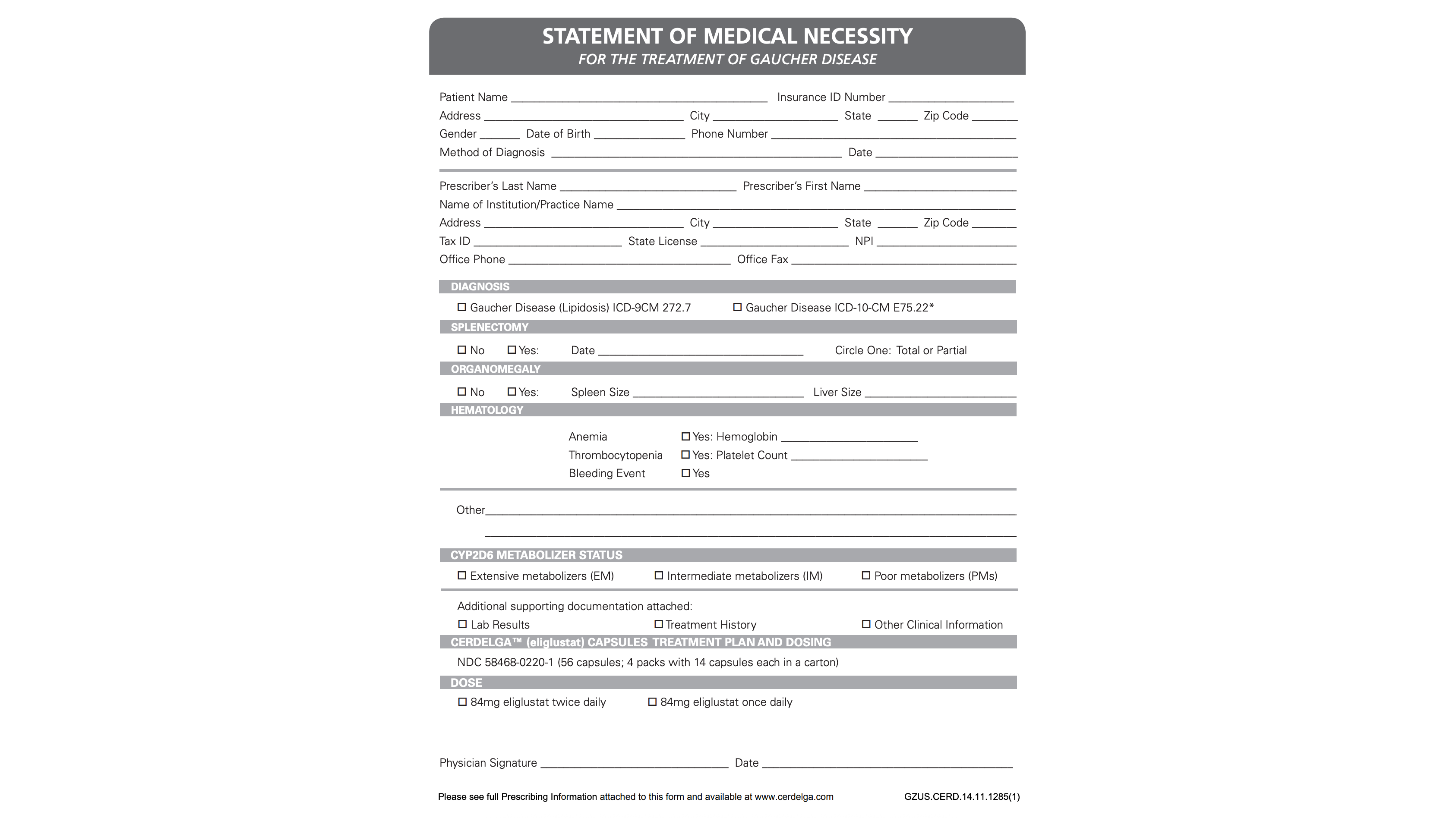.png)
%20(1).png)
%20(1).png)
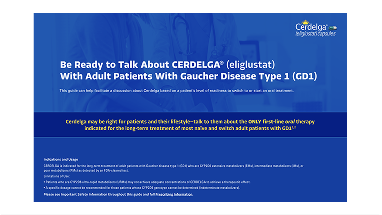%20(1).png)
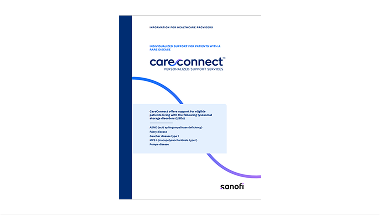.png)
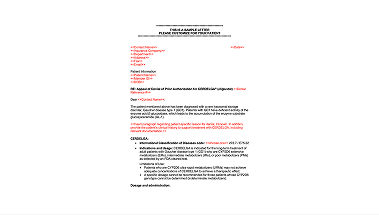.png)
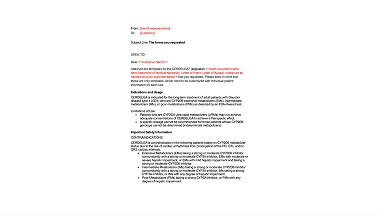.png)